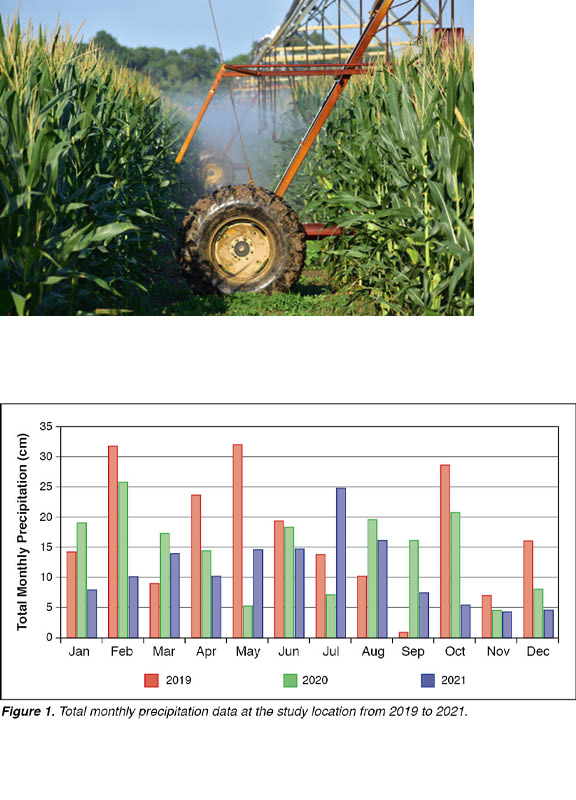Research Project
Sensor-Based Irrigation Scheduling and Cover Crop Impacts on Corn Production
Investigators: Dillon Russell, Gurpreet Kaur, Gurbir Singh
Date: 2021
Project Summary
Introduction
The Mississippi Delta accounts for the majority of the state’s total corn production and is primarily furrow-irrigated. Excessive irrigation for row-crop production has caused significant declines in the Mississippi River Valley Alluvial Aquifer. Previous research has been conducted utilizing soil moisture sensors to mitigate the over-consumption of this aquifer; however, combining the benefits of soil moisture sensors with winter cover crops has not been documented. After decomposition, cover crop residues act as a mulch and can improve soil water retention (Sullivan et al., 1991). Cover crops also can improve water infiltration through the creation of sub-surface root channels (Blanco-Canqui et al., 2015). Therefore, the objective of this study was to determine if combinations of irrigation scheduling thresholds and cover crops could improve corn grain yield, water productivity, and irrigation water use efficiency (IWUE) in the Mississippi Delta.
Materials and Methods
A field experiment was conducted at the National Center for Alluvial Aquifer Research in Leland, MS from 2019 to 2021. The soil classification on the study site was a Bosket very fine sandy loam soil (Fine-loamy, mixed, active, thermic Mollic Hapludalfs). The experiment was designed as a randomized complete block with four replications. Each replication included 12 four-row plots (each 13 ft. × 100 ft) on 40” in. row spacing. Treatments in this study included combinations of irrigation scheduling thresholds (no irrigation, -40 kPa sensor threshold, and -90 kPa sensor threshold) and cover crops (no cover crop, cereal rye, hairy vetch, and wheat-radish-turnip mix). Cover crops were planted with a grain drill in the fall and chemically terminated in the spring before planting corn. The seeding rate for the cereal rye and hairy vetch were 60 lb/ac and 20 lb/ac, respectively. The seeding rate for the mix included 40 lb/ac wheat, 4 lb/ac radish, and 2 lb/ac turnip. The corn hybrid selected for this study was Dekalb 70-27 planted at 32,000 seeds/ ac. Irrigation was applied via polyethylene tubing and was initiated when the weighted average of the sensors reached the respective threshold assigned to the treatment. Data collection included corn grain yield, water productivity (yield divided by the sum of rainfall and irrigation), and irrigation water use efficiency (yield divided by irrigation). Rainfall data used to calculate water productivity was collected from the National Weather Service’s Cooperative Observing Station located in Stoneville, MS (Figure 1).
Results and Discussion
In the first year of this study, cover crop treatments negatively impacted corn grain yield as the no cover crop control treatment produced 9, 19, and 26% higher corn grain yield compared to cereal rye, wheat-radish-turnip mix, and hairy vetch treatments, respectively. Water productivity was at least 16% higher in no cover crop treatments under the -90 kPa irrigation threshold compared to all other treatments. Only two treatments reached their respective sensor thresholds for irrigation initiation in year one, which were cereal rye and hairy vetch under the -40 kPa irrigation threshold. Of those two, hairy vetch contained 21% higher IWUE. In year two, -40 kPa irrigation treatments produced 8 and 9% higher corn grain yield compared to no irrigation and -90 kPa irrigation threshold, respectively, while no differences were observed among the cover crop treatments. Water productivity was 6 and 17% higher in no irrigation treatments compared to -90 kPa and -40 kPa irrigation thresholds, respectively, while IWUE was at least 108% higher in the -90 kPa hairy vetch treatments compared to all other treatments (Table 1).
Conclusion
In year one, cover crops with irrigation thresholds negatively impacted corn yield and had practically no beneficial impacts on water productivity; however, hairy vetch treatments showed to improve IWUE regardless of the irrigation threshold. In year two, corn yields were much higher and were similar across all cover crop treatments, but the -40 kPa irrigation threshold treatments yielded higher than the other irrigation treatments. Additionally, hairy vetch treatments had the highest water productivity among cover crop treatments, while also showing drastically higher IWUE under the -90 kPa irrigation threshold in year two. Slowly, improvements were observed between cover crops and irrigation thresholds, but further evaluation is needed to determine the recommended cover crop and irrigation threshold to maximize corn production in the Delta region.
References
Blanco-Canqui, H., Shaver, T. M., Lindquist, J. L., Shapiro, C. A., Elmore, R. W., Francis, C. A., & Hergert, G. W. (2015). Cover crops and ecosystem services: Insights from studies in temperate soils. Agronomy Journal, 107(6), 2449-2474.
Sullivan, P. G., Parrish, D. J., & Luna, J. M. (1991). Cover crop contributions to N supply and water conservation in corn production. American Journal of Alternative Agriculture. 6(3), 106-113.
Project Photos

- Crop Type:
- Corn
- Topic:
- Irrigation Scheduling
- Irrigation
- Cover Crops
Find Research
By Crop Type
By Topic
Contact NCAAR
General Information
Kaye Sullivan
vfs23@msstate.edu
662.390.8510
F:662.390.8501
Showcase Demo
Drew Gholson, Coordinator
drew.gholson@msstate.edu
662.390.8505
Himmy Lo
himmy.lo@msstate.edu
662.390.8509

